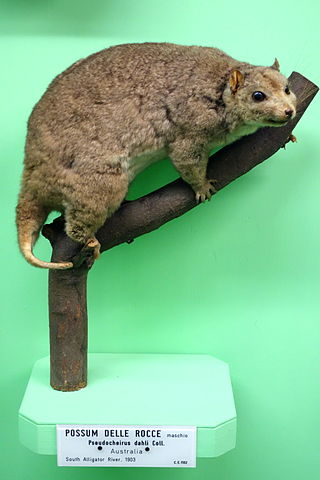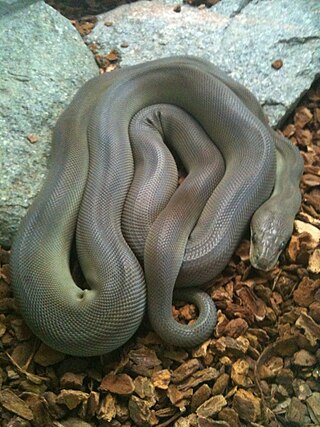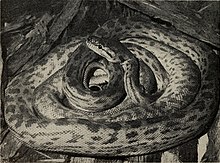
The Rainbow Serpent or Rainbow Snake is a common deity often seen as the creator God, known by numerous names in different Australian Aboriginal languages by the many different Aboriginal peoples. It is a common motif in the art and religion of many Aboriginal Australian peoples. Much like the archetypal mother goddess, the Rainbow Serpent creates land and diversity for the Aboriginal people, but when disturbed can bring great chaos.

Morelia spilota, commonly known as the carpet python, is a large snake of the family Pythonidae found in Australia, New Guinea, Bismarck Archipelago, and the northern Solomon Islands. Many subspecies are recognised; ITIS lists six, the Reptile Database six, and the IUCN eight.

Children's python is a species of nonvenomous snake in the family Pythonidae. The species is named after John George Children. It is a nocturnal species occurring in the northern half of Australia and generally found on the ground, although it often climbs trees. Usually growing to about 1.0 m (3 ft) in length or more depending on the polymorphic variant, it is typically a reddish-brown colour, darker on the upper surface, and with many darker blotches, especially on younger specimens. The Stimson's python variant has much stronger and more variable colours; often being adorned with reddish-brown to chocolate blotches against lighter tan. It feeds mostly on small mammals and birds, and as with other pythons, it constricts its prey before swallowing it whole. It is a popular pet among reptile enthusiasts.

Gunbalanya is an Aboriginal Australian town in west Arnhem Land in the Northern Territory of Australia, about 300 kilometres (190 mi) east of Darwin. The main language spoken in the community is Kunwinjku. At the 2021 Australian census, Gunbalanya had a population of 1,177.
Allosyncarpia ternata, commonly known as an-binik, is a species of rainforest trees constituting part of the botanical family Myrtaceae and included in the eucalypts group. The only species in its genus, it was described in 1981 by Stanley Blake of the Queensland Herbarium. They grow naturally into large, spreading, shady trees, and are endemic to the Northern Territory of Australia. They grow in sandstone gorges along creeks emerging from the Arnhem Land plateau.

Morelia bredli is a species of non-venomous snake in the family Pythonidae. The species is endemic to Australia. No subspecies are recognized. Its common names include Bredl's python, the Centralian python, the Centralian carpet python, the central Australian carpet python, Bredl's carpet python, the central Australian Bredl's carpet python, and the central Bredl's carpet python.

The amethystine python, also known as the scrub python or sanca permata in Indonesian, is a species of non-venomous snake in the family Pythonidae. The species is found in Indonesia and Papua New Guinea. Popular among reptile enthusiasts, and noted for its coloration and size, it is one of the largest snakes in the world, as measured either by length or weight, and is the largest native snake in Papua New Guinea. Until 2000, the larger S. kinghorni was generally considered a subspecies of S. amethistina, and this change of classification has still not been universally reflected in literature. Because of this issue, S. amethistina has often been described as the largest snake in Australia, but this is not accurate since under the current classification, this species does not occur in Australia.

The rough-scaled python is a large-scaled python species endemic to Australia. No subspecies are currently recognized.

The rock-haunting ringtail possum, also known as the rock ringtail possum, is a species of Australian possum. It is found in rocky escarpments in the Kimberley, Arnhem Land and Gulf of Carpentaria across Western Australia and Northern Territory and just passing the Queensland border. It is also found on Groote Eylandt. It is the only species in the genus Petropseudes, but is part of the group including the common ringtail possum.

Simalia is a genus of snakes in the family Pythonidae.
The Pythonoidea, also known as pythonoid snakes, are a superfamily of snakes that contains pythons and other closely related python-like snakes. As of 2022, Pythonoidea contains 39 species, including the eponymous genus Python and 10 other genera of pythons, all in the family Pythonidae, as well as two lesser-known families, Loxocemidae and Xenopeltidae.

Morelia spilota spilota is a subspecies of carpet python, popularly known as the diamond python. It is a medium to large snake, found in coastal areas and adjacent ranges of south-eastern Australia. It is the most southerly occurring python in the world and is found at higher altitudes than any other species of Australian python.

The olive python is a species of snake in the family Pythonidae. The species is endemic to Australia. Two subspecies are recognized, including the nominate subspecies described here.

Simalia tracyae, the Halmahera python, is a species of python found only on the Indonesian island of Halmahera. It belongs to the family Pythonidae and the genus Simalia. This snake was previously believed to have belonged to the Simalia amesthistina species; however, studies in recent years have caused scientists to distinguish between the two types of snakes, resulting in the reclassification of the Halmahera python as its own species.

The Australian scrub python, also known commonly as Kinghorn's python and simply as the scrub python is a species of snake in the family Pythonidae. The species is indigenous to forests of northern Australia. It is one of the world's longest and largest snakes, and is the longest and largest in Australia. In 2014 it was reclassified to the genus Simalia alongside a few other former Morelia species, but scientific debate over this continues.
The Bininj are an Aboriginal Australian people of Western Arnhem land in the Northern Territory. The sub-groups of Bininj are sometimes referred to by the various language dialects spoken in the region, that is, the group of dialects known as Bininj Kunwok; so the people may be named the Kunwinjku, Kuninjku, Kundjeyhmi (Gundjeihmi), Manyallaluk Mayali, Kundedjnjenghmi and Kune groups.
Morelia azurea is a species of snake. Commonly known as the northern green tree python, this arboreal python was previously included in the Morelia viridis species complex.

Crocosaurus Cove is a crocodile herpetarium and aquarium attraction located in an indoor-outdoor complex in the city district of Darwin, Northern Territory, Australia. Its main focus, as the facility's name indicates, is the tourism drawcard of northern Australia – crocodiles.















